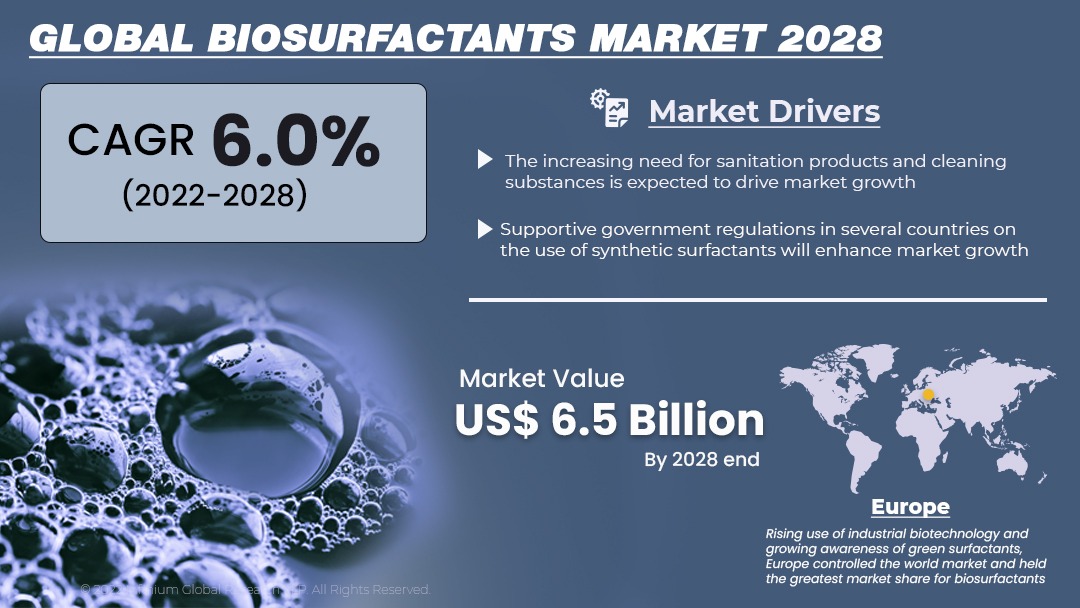Biosurfactants Market (Product Type - Sorbitan Esters, Sucrose Esters, Rhamnolipids, Sophorolipids, Methyl Ester Sulfonates (MES), and Others; Application - Detergents and Industrial Cleaners, Cosmetics and Personal Care, Food Processing, Oilfield Chemicals, Agricultural Chemicals, Textiles, and Other Applications): Global Industry Analysis, Trends, Size, Share and Forecasts to 2028
A recent report published by Infinium Global Research on the biosurfactants market provides an in-depth analysis of segments and sub-segments in the global as well as regional biosurfactants market. The study also highlights the impact of drivers, restraints, and macro indicators on the global and regional biosurfactants market over the short term as well as long term. The report is a comprehensive presentation of trends, forecasts, and dollar values of the global biosurfactants market. According to the report, the global biosurfactants market is projected to grow at a CAGR of Approximately 6% over the forecast period of 2022-2028.
Market Insight
The biosurfactants Market was valued at over nearly USD 4.5 Billion in 2022 and is expected to reach about USD 6.5 Billion in 2028, with a CAGR of Approximately 6% during the forecast period. Biosurfactants are biologically derived surface-active agents that have the flexibility to reduce the surface tension between solids, gases, and liquids. Biosurfactants are allowing them to disperse and blend in water or other liquids readily. They're chemical compounds having amphiphilic nature, i.e., having both a hydrophilic polar group and a hydrophobic non-polar group. Here, the polar 'head' is a phosphate, amino acid, or carbohydrate, and also the non-polar tail is usually a hydrocarbon chain. The rising need for enhancing crop productivity represents one of the key factors positively influencing the use of biosurfactants within the agriculture industry.
In the creation of laundry and home cleaning solutions, surfactants play a vital role. Modern detergents include chemical surfactants, softeners, oxidizing agents, and various enzymes among their ingredients. The increased public knowledge of environmental issues and concerns related to compound surfactants has renewed interest in finding eco-friendly characteristic substitutes for them in garment cleaners. Regulations must be changed due to the harmful impacts of synthetic surfactants. The primary operating firms are being driven by the preservatives in personal care products to produce unique biosurfactants and natural preservatives in personal care products that are sourced from natural sources. Alkyl polyglucosides, glycolipids, plant extracts, essential oils, organic acids, and aromatic alcohol are examples of biosurfactants and natural preservatives. Many industries are sure that their goods won't be changed in any way. As a result, this business was significantly impacted by technological breakthroughs. The brand owner carefully examines the technologies that are introduced to the market before making important decisions about product development. Customers are unable to bear the risks associated with doing business with a single manufacturer. Therefore, a lack of producers of biosurfactants can prevent further development. Regulation modifications are found to be necessary according to growth opportunities for functional ingredients in personal care. As a result, firms are innovating to include biosurfactants and natural preservatives in their products. The products that are produced from natural sources are due to the negative impacts of synthetic surfactants and preservatives in personal care goods. Significant advancements have been made in biosurfactants and natural preservatives, particularly alkyl polyglucosides, glycolipids, plant extracts, essential oils, organic acids, aromatic alcohols, and their mixtures.

The market is divided into four categories based on geographies such as North America, Asia Pacific, Europe, and the Rest of the World. Due to the rising use of industrial biotechnology and growing awareness of green surfactants, Europe controlled the world market and held the greatest market share for biosurfactants. Additionally, stringent restrictions on chemical consumption will improve market penetration in the area. With a sizable market for bio-based- based surfactants, North America is an area that is quickly growing. Growing concern about the harmful effects of the chemicals released by chemical surfactants after decomposition is expected to change consumer choices. The market is projected to expand as expenditure on cleanliness and general well-being increases. Additionally, the petroleum and oil industry's increasing need for biosurfactants for oil recovery is anticipated to encourage expansion.
Segment Covered
The report on the global biosurfactants market covers segments such as product type, and application. On the basis of product type, the sub-markets include sorbitan esters, sucrose esters, rhamnolipids, sophorolipids, methyl ester sulfonates (MES), and others. On the basis of application, the sub-markets include detergents and industrial cleaners, cosmetics and personal care, food processing, oilfield chemicals, agricultural chemicals, textiles, and other applications.
Companies Profiled:
The report provides profiles of the companies in the market such as Solvay S.A., Evonik Industries AG, Deguan Biosurfactant, Biotensidon GmbH, Saraya Co., Ltd., Allied Carbon Solutions Co., Ltd., Jeneil Biotech, Inc., BASF SE, Croda, and Holiferm Limited.
Report Highlights:
The report provides deep insights into demand forecasts,
market trends, and micro and macro indicators. In addition, this report
provides insights into the factors that are driving and restraining the growth
in this market. Moreover, The IGR-Growth Matrix analysis given in the report
brings insight into the investment areas that existing or new market players
can consider. The report provides insights into the market using analytical
tools such as Porter's five forces analysis and DRO analysis of the biosurfactants
market. Moreover, the study highlights current market trends and provides
forecasts from 2022-2028. We also have highlighted future trends in the market
that will affect the demand during the forecast period. Moreover, the
competitive analysis given in each regional market brings insight into the
market share of the leading players.
Please Choose One of them.